The watercraft... Hobie island
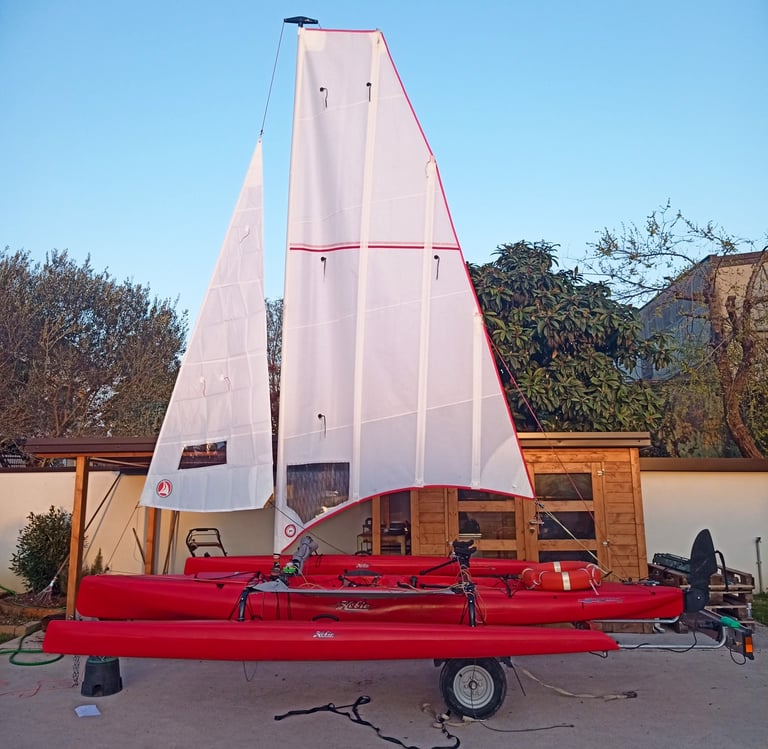

With a length of approximately 5 metres and a sail area of just over 6 m², this trimaran is stable and safe, ideal for excursions in inland and marine waters, perfect for those seeking adventure, fishing or simply a fun and versatile way to explore the water.
The 2017 Hobie Adventure Island trimaran is an extraordinary single-person boat that combines the versatility of a kayak with the excitement of sailing and the convenience of pedal propulsion.
Accessible to both beginners and experienced sailors, it stands out for its quick set-up and ease of use.
This model is easily collapsible and transportable on a trailer, with an assembly time of 15-20 minutes.
The MirageDrive propulsion system allows you to pedal without using your hands, enabling you to move even when the wind drops.
It features a movable centreboard that can be raised, allowing you to explore shallow waters and beach the trimaran to sleep on unexplored beaches.
Ample storage space includes a compartment in the bow and a large rear tank for equipment or supplies. I filled the interior of the boat with many empty water bottles to create a reserve of buoyancy in case of a leak or breakage of the plastic hull.
I added two trampoline nets to extend the walking and cargo space, attaching watertight bags and everything that needs to be kept close at hand.
The seat is very comfortable and allows you to cycle for 8-9 hours without any discomfort.
The main sail is a furling mainsail on a 5-metre carbon mast; the mast is rotating and without a boom, allowing for quick and safe sail reduction, equipped with vertical battens that guarantee excellent support and efficiency.
The rudder and retractable centreboard ensure stability and control even in crosswinds. It is not a boat designed for close-hauled sailing, but pedalling increases the apparent wind, allowing the boat to sail at an angle of up to 50-55° with a full mainsail and winds of up to 12-14 knots. When you start to reduce the mainsail, however, the boat sails much less tightly.
I added a small jib to the original sail plan, which can be hoisted with a closed-loop halyard, allowing the jib to be raised or lowered to seek higher wind in light breezes.
On my trimaran, it is also possible to replace the jib with a gennaker, which can be used in winds up to 12-14 knots; I don't use it much because in Croatia the afternoon breeze often exceeds 14-16 knots, and handling the gennaker becomes complicated.
I replaced the original mainsail, which had slanted battens, with one made by the sailmaker with completely vertical battens, as the slanted batten system often caused problems when partially closing the sail. During my trips to Croatia, strong thermal winds often rise in the afternoon with tailwinds; in these conditions, I close the mainsail slightly to give full air to the jib, lightening the helm and stabilising the boat. This prevents the boat from broaching, shifting the centre of the sail further forward, and allows for better control when surfing the waves as they grow in the afternoon and evening, after the thermal wind has been blowing for hours.
Sail plan:
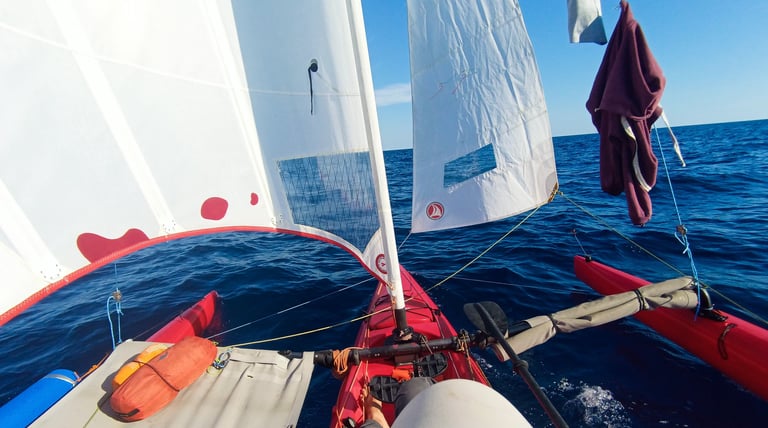

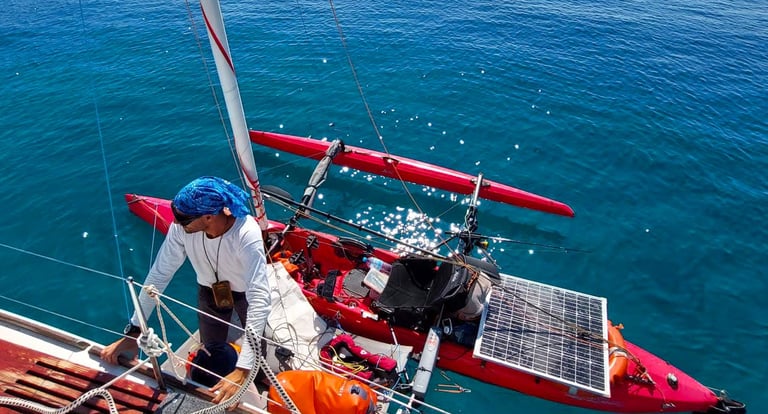

What started out as an almost ridiculous game, moving an autopilot for sailing boats onto this ‘toy’ trimaran, eventually became a great ally for long coastal voyages.
The autopilot is a Raymarine ST2000+ with a worm gear actuator; I positioned it on the left side arm, building an intricate system of ropes and blocks that reduces the large range of motion of the pilot (designed for sailing boats) and adapts it to the small trimaran.
After some endless testing and modifications, it now works perfectly and has accompanied me for 80% of my journey from Monfalcone to Lastovo, covering about 300 nautical miles. During the trip from Trieste to Dubrovnik, however, it broke down several times due to moisture and condensation.
The autopilot is very convenient and allows you to relax or do other things while the boat sails autonomously. It holds its course perfectly in light winds, but tends to be less accurate when sailing downwind in stronger winds and waves. In other conditions, however, it performs very well even in moderate winds.
Autopilot:
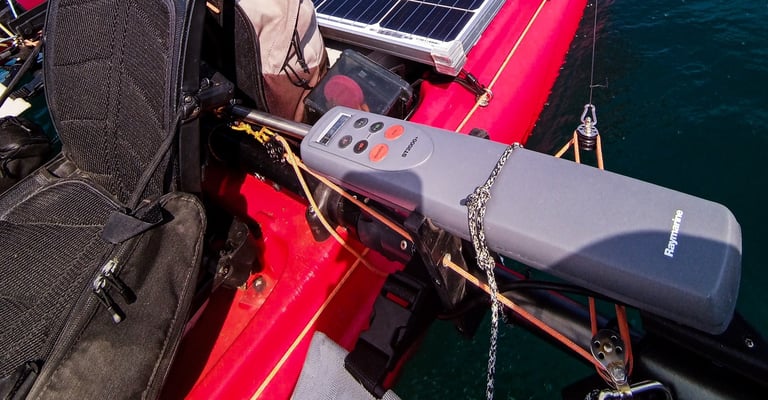

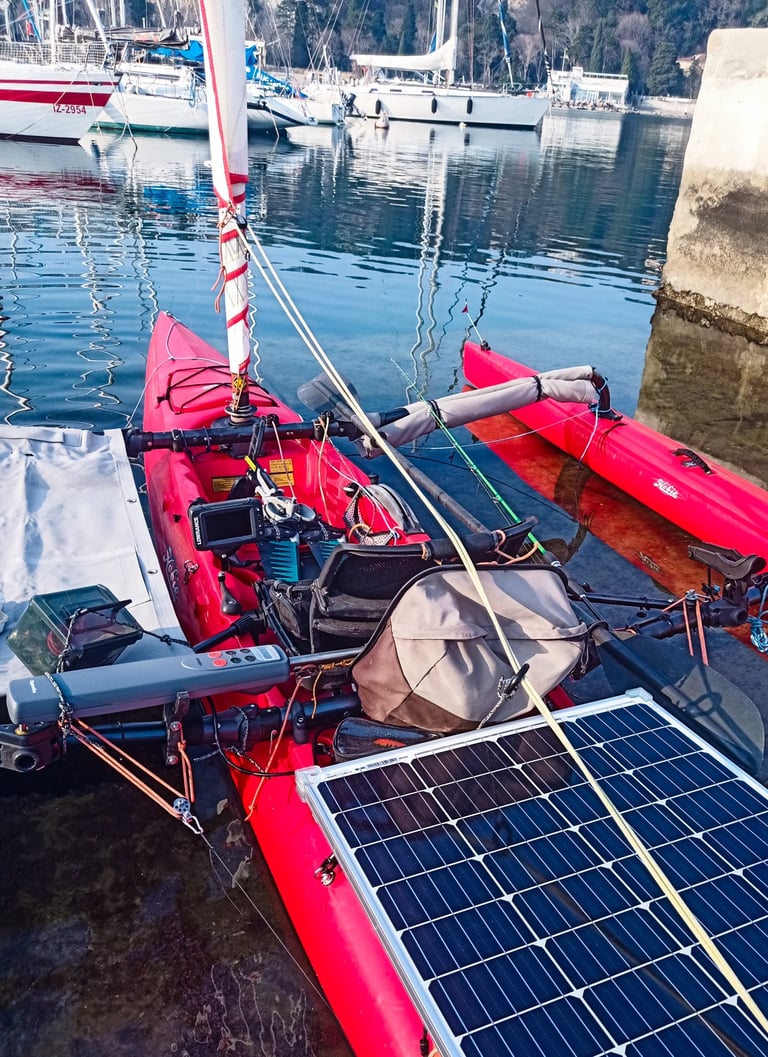

Energy independence and photovoltaic systems:
For power on board, I use two PoweryMax kayak batteries, each with a capacity of 10 Ah. These are high-quality, reliable lithium-ion batteries.
The 12 V DC system powers the chart plotter and autopilot during navigation. One battery is located in a watertight box on board, while the other, connected via external cables, is located in the seat pocket so that it can be removed and taken to the tent for overnight charging of smartphones, cameras, tent lights, etc.
The batteries are charged via a 90 W solar panel fixed to the stern, connected to a Victron charge controller. They can be charged one at a time and, during daily use, you can choose whether to power the system with the battery being charged or the one already charged, thus manually managing the charge level according to your needs and the weather.
The charging system is contained in a removable watertight box attached to the stern.
A minimum of attention must be paid to managing consumption, but on a sunny day the system is sufficient to charge both batteries and simultaneously provide continuous power to the GPS and autopilot.
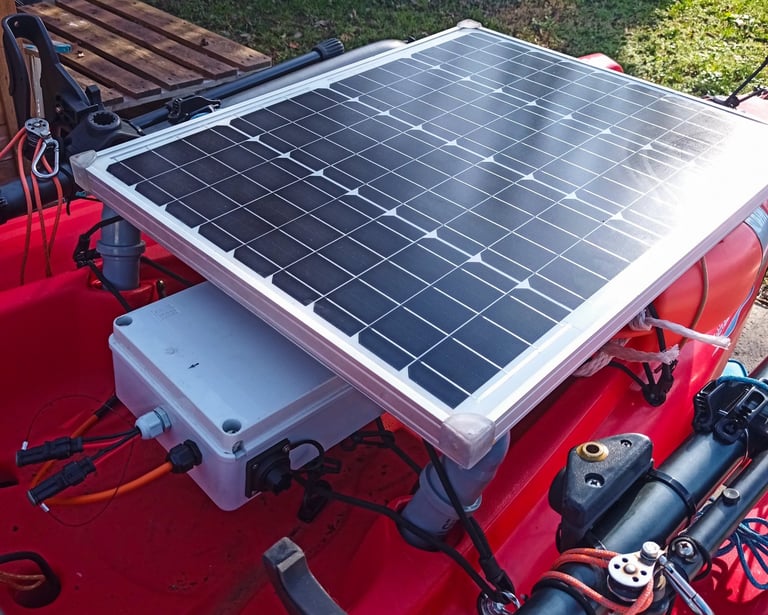

Before my last adventure, I modified the bow by adding an aluminium bowsprit. I placed it on the plastic and bolted it to the halyard handle screws, which are embedded in the plastic. The bowsprit is useful for increasing the space between the jib and the mainsail, which in some conditions was too limited, causing a loss of sail efficiency.
With the jib hoisted, the boat sails a little less close to the wind, but if necessary, it can always be lowered and the boat sailed using only the mainsail. When sailing beam reach, broad reach and downwind, the jib increases the speed of this small trimaran by about 30-35%.
Structural changes:
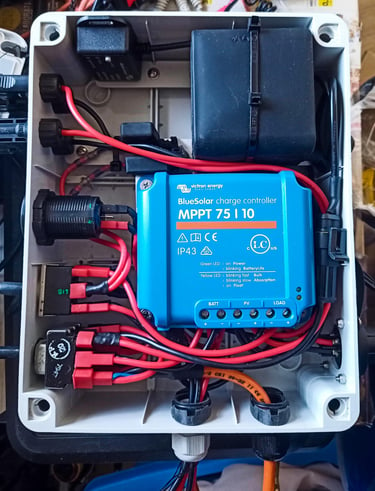

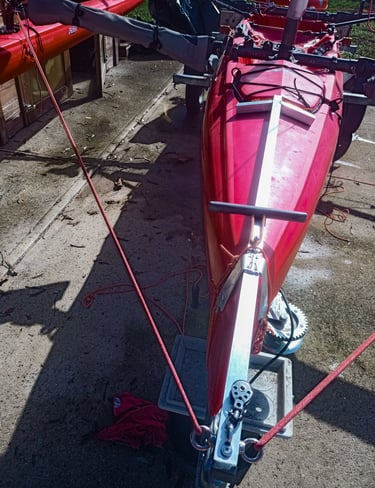

Frequently Asked Questions
What are your watercraft?
I use pedal and rowing kayaks, Hobie trimarans with sails and pedals, and a small sailing boat.
What are your next travel plans?
Yes, I share my travel experiences and photographs on the website, inspiring other travellers.